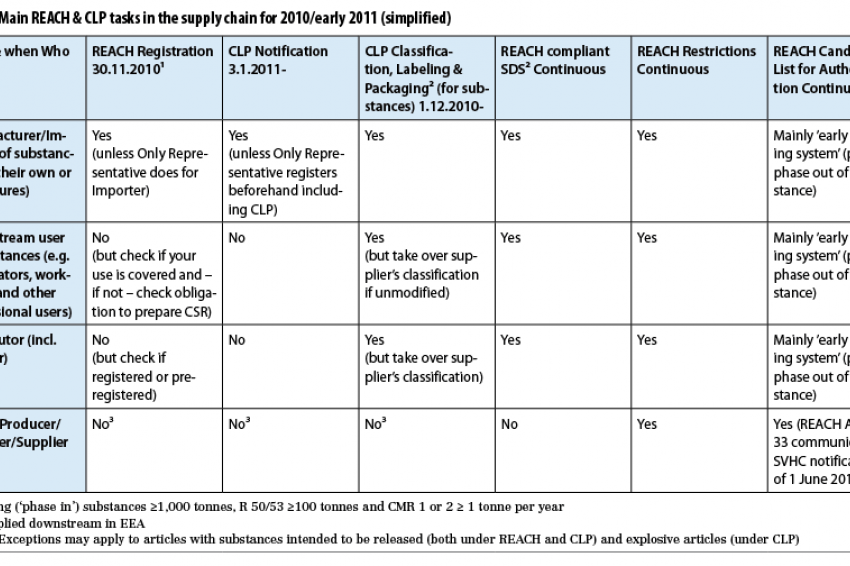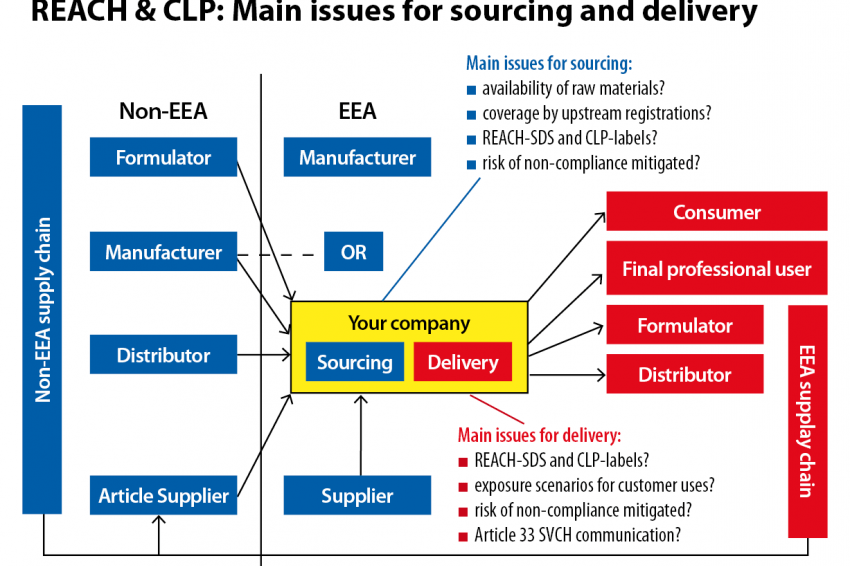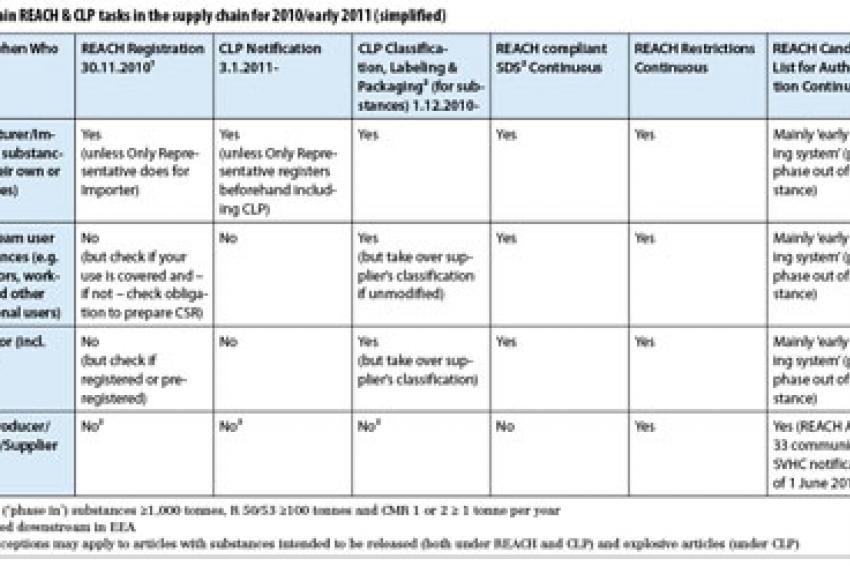Reach and CLP Compliance in Supply Chain
2010 – The ‘Big Bang Year’ For European Chemicals Industry
30.11.2010, 1.12.2010 and 3.1.2011 - These three coinciding dates are the deadlines that European companies manufacturing, importing or otherwise dealing with chemicals must meet in order to continue business on the EEA market beyond this year. The deadlines are foreseen in two groundbreaking new pieces of EU legislation directly applicable in all 27 EU member states as well as Norway, Iceland and Liechtenstein (together EEA): Reach and CLP Regulations (Classification, Labeling and Packaging of substances and mixtures). Tim Becker from environmental consultancy ReachLaw, the recent winner of the Internationalization Award 2009 from Finland's President Tarja Halonen, highlights major tasks ahead and considerations for supply chain managers eager to secure availability of raw materials and to keep their company's products on the EEA market after 2010.
Combine Reach and CLP Processes
Whereas Reach is already quite well known in industry, CLP has been living a somewhat shadowy existence behind the complex "Reach monster." However, the general consequence of non-compliance is the same for both: Substances must not be placed on the EEA market, unless they have been pre-/registered, comply with authorization and restriction requirements under Reach and are classified, labeled, packaged and notified in accordance with CLP; also mixtures (formerly known as "preparations") and certain articles are affected by these requirements (fig. 1). Companies are advised to address Reach and CLP together, also from an organizational point of view, as these acts are closely interlinked.
What Is At Stake For Business?
Companies will encounter the business impact of Reach and CLP both on the sourcing and the delivery side. On the sourcing side, un-registered or very hazardous raw materials may disappear and suppliers might not support certain uses (e.g. other than intermediate uses) in their registration dossiers or they could even discontinue business altogether. In fact, the gap between the number of known lead registrants (2,400 as per Feb. 24) and the estimated number of substances to be registered in 2010 (up to 9,000 according to the European Chemicals Agency, ECHA) is still alarming. On the delivery side, customers will seek to receive products, which have been pre-/registered including their use, are accompanied by Reach compliant safety data sheets and labeled according to CLP, if applicable. On both sides, parties may try to shift or reduce responsibilities, costs and compliance risks in supply contracts. Major compliance issues for companies in the supply chain are the possibility to rely on compliance acts performed by actors upstream (notably Reach registration and safety data sheet, CLP classification, labeling and notification), the availability of substance information to perform those acts on their own and communication of chemical safety information up and down the supply chain (fig. 2). In practice, close interaction between supply chain managers, EHS and legal department is required to deal with all these impacts within a company.
What Should Already Be Done?
Pre-registrations should have been performed by Dec. 1, 2008, for existing ("phase-in") substances reaching 1 ton or more per year. Even though the submission of a pre-registration to ECHA was straightforward, the right substance identification posed most problems, especially in case of substances in mixtures and substances of unknown or variable composition (so-called "UVCBs"). There were frequent mistakes made in these cases, which call into question the validity of pre-registration and whether the pre-registrant may change over from the "wrong" to the "right" SIEF or has to stop business until registration is completed.
Already as of June 1, 2007, suppliers of substances or mixtures classified as dangerous should automatically provide their customers (except consumers) with a safety data sheet compiled in accordance with Annex II of the Reach Regulation. The safety data sheets will require significant updates, as the results of registrations (incl. exposure scenarios) as well as CLP classification and labeling become available.
How to Rely On Compliance Acts Up the Supply Chain
The obligations to register under Reach and to notify under CLP are in principal only on manufacturers and importers from outside EEA of substances (on their own or in mixtures). Therefore, when you purchase raw materials (substances or mixtures), it makes a big difference whether your supplier is based inside or outside the EEA.
If your supplier is located inside the EEA, you will normally be regarded as "distributor" or "downstream user" (e.g. if you are a formulator or other professional user) and thus you do not have to register under Reach or notify under CLP, unless you are using the material to manufacture another substance. In this case, you need to make sure that the substance is being timely registered or notified upstream and the registration is covering your own or your customers' uses of the substance. This can be done through information requests, communications of uses (according to ECHA's Use Descriptor System) and conditions of use or contractual arrangements with your suppliers. On the other hand, the fact that your use is or will not be included or is advised against in the registration dossier (which may become apparent when you receive a safety data sheet with exposure scenarios not covering your use) does not necessarily mean that you have to stop purchasing from that supplier. However, in that case you may have to make your own chemical safety assessment and inform ECHA of that use, within certain deadlines specified in the Reach regulation. Alternatively, you may decide to change the supplier or substance.
If your supplier is located outside EEA, things become more difficult. In principle, you are regarded as importer and have to register substances imported on their own or in mixtures and notify their classification and labeling according to CLP to ECHA. However, your non-EU supplier may have appointed an only representative (OR) to carry out registration and other importer obligations under Reach. As a consequence, importers covered by the OR registration (including CLP classification and labeling) do not have to register a second time and are also relieved from CLP notification. Importers that wish to rely on an OR registration, should proceed as outlined before for other downstream users, i.e. make sure that their substances are registered in time including their uses and also CLP classification and labeling. In addition these importers should ensure that the OR actually covers their company and the volumes supplied to them in his registration. Importers of mixtures are expected to face particular challenges with regard to CLP notification, as an OR will in many cases not register in 2010 (due to lower tonnage bands) and the exact mixture composition is often unknown and regarded as a highly valued trade secret by the non-EU supplier.
Conclusions
2010 is a real showdown for the European chemical industry with Reach and CLP going in decisive stages and time to act being scarce. With increasing enforcement activities expected latest after Dec. 1, 2010, only those companies will come through undamaged, that know their raw materials, uses, products, how to classify them under Reach and CLP and understand what their associated roles, responsibilities and options to act are. For actors in the supply chain these tasks are more complex than for say mere manufacturers or end users. Supply chain managers are advised not to play a lone hand, but to collaborate closely with EHS and legal departments to ensure Reach and CLP compliance for purchased raw materials and delivered products.
Visit ReachLaw at the Logichem in Dusseldorf from April 20-22!
Contact
ReachLaw
Keilaranta 15
02150 Espoo
Finland
+358 50 5871640









